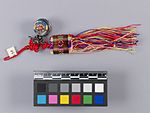chil-bo-eun-gab-no-ri-gae (Tassel Ornament)
About this object
History of use
There were many kinds of tassel ornaments “no-ri-gae” in the Chosun Dynasty, worn either hanging from the ribbon tie of the upper garment “jo-go-ri” or from the waist tie. Bells and small cases were added for children. Silver was commonly used for ornaments in the Chosun Dynasty. The cases were used to contain incense or medicines to revive children, called “chung-sim-hwan” The tassels worn by children were more colourful than those worn by adults. Auspicious characters were used to protect children, as their survival was precarious at that time. The metal bells, cases, and tassels were made by specialists, but the ornaments likely were created by children’s mothers.
Iconographic meaning
The pink cord indicates that the child wearing the ornament was a girl.
Physical description
An ornament made of an elaborately knotted pink cord with a round silver box that has a swiveling lid and two tassels attached. Above the box, there is a loop, below which, there is a flat knotted lozenge shape. Below the box, there is a smaller looped pattern. The box is attached with an elaborate winged loop of silver. The box is inlaid with enamel in floral patterns of blue, blue-green, yellow, and purple with a coral bead inset on each side. Two tassels are attached below the second knotted design. They have multicoloured strands, and are wrapped at the top with gold thread that has a pattern picked out of the tassels’ strands on the surface of each wrapped area.
Categories
Materials
Date Made
Late Chosun Dynasty (before 1939)
Date Acquired
Aug 1964
How Acquired
Donated
Credit Line
Measurements
Overall: 14 cm x 5 cm x 1.8 cm
Object Number
N3.39
